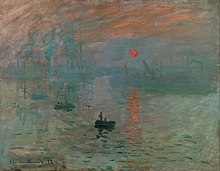Style is used in two senses: It can refer to the distinctive visual elements, techniques, and methods that typify an individual artist’s work. It can also refer to the movement or school that an artist is associated with. This can stem from an actual group that the artist was consciously involved with or it can be a category in which art historians have placed the painter. The word ‘style’ in the latter sense has fallen out of favor in academic discussions about contemporary painting, though it continues to be used in popular contexts. Such movements or classifications include the following
Modernism
Modernism describes both a set of cultural tendencies and an array of associated cultural movements, originally arising from wide-scale and far-reaching changes to Western society in the late 19th century and early 20th century. Modernism was a revolt against the conservative values of realism.[59][60] The term encompasses the activities and output of those who felt the “traditional” forms of art, architecture, literature, religious faith, social organization, and daily life were becoming outdated in the new economic, social, and political conditions of an emerging fully industrialized world. A salient characteristic of modernism is self-consciousness. This often led to experiments with form, and work that draws attention to the processes and materials used (and to the further tendency of abstraction).[61]
Impressionism
[edit]

The first example of modernism in painting was impressionism, a school of painting that initially focused on work done, not in studios, but outdoors (en plein air). Impressionist paintings demonstrated that human beings do not see objects, but instead see light itself. The school gathered adherents despite internal divisions among its leading practitioners and became increasingly influential. Initially rejected from the most important commercial show of the time, the government-sponsored Paris Salon, the Impressionists organized yearly group exhibitions in commercial venues during the 1870s and 1880s, timing them to coincide with the official Salon. A significant event of 1863 was the Salon des Refusés, created by Emperor Napoleon III to display all of the paintings rejected by the Paris Salon.
Abstract styles
[edit]
Abstract painting uses a visual language of form, colour and line to create a composition that may exist with a degree of independence from visual references in the world.[62][63] Abstract expressionism was an American post-World War II art movement that combined the emotional intensity and self-denial of the German Expressionists with the anti-figurative aesthetic of the European abstract schools—such as Futurism, Bauhaus and Cubism, and the image of being rebellious, anarchic, highly idiosyncratic and, some feel, nihilistic.[64]
Action painting, sometimes called gestural abstraction, is a style of painting in which paint is spontaneously dribbled, splashed or smeared onto the canvas, rather than being carefully applied.[65] The resulting work often emphasizes the physical act of painting itself as an essential aspect of the finished work or concern of its artist. The style was widespread from the 1940s until the early 1960s and is closely associated with abstract expressionism (some critics have used the terms “action painting” and “abstract expressionism” interchangeably).
Other modernist styles include:
Outsider art
[edit]
The term outsider art was coined by art critic Roger Cardinal in 1972 as an English synonym for art brut (French: [aʁ bʁyt], “raw art” or “rough art”), a label created by French artist Jean Dubuffet to describe art created outside the boundaries of official culture; Dubuffet focused particularly on art by insane-asylum inmates.[66] Outsider art has emerged as a successful art marketing category (an annual Outsider Art Fair has taken place in New York since 1992). The term is sometimes misapplied as a catch-all marketing label for art created by people outside the mainstream “art world,” regardless of their circumstances or the content of their work.
Photorealism
[edit]
Photorealism is the genre of painting based on using the camera and photographs to gather information and then from this information, creating a painting that appears to be very realistic like a photograph. The term is primarily applied to paintings from the United States art movement that began in the late 1960s and early 1970s. As a full-fledged art movement, Photorealism evolved from Pop Art[67][68][69] and as a counter to Abstract Expressionism.
Hyperrealism is a genre of painting and sculpture resembling a high-resolution photograph. Hyperrealism is a fully-fledged school of art and can be considered an advancement of Photorealism by the methods used to create the resulting paintings or sculptures. The term is primarily applied to an independent art movement and art style in the United States and Europe that has developed since the early 2000s.[70]
Surrealism
[edit]
Surrealism is a cultural movement that began in the early 1920s and is best known for the artistic and literary production of those affiliated with the Surrealist Movement. Surrealist artworks feature the element of surprise, the uncanny, the unconscious, unexpected juxtapositions and non-sequitur; however, many Surrealist artists and writers regard their work as an expression of the philosophical movement first and foremost, with the works being an artifact. Leader André Breton was explicit in his assertion that Surrealism was above all a revolutionary movement.
Surrealism developed out of the Dada activities of World War I and the most important center of the movement was Paris. From the 1920s onward, the movement spread around the globe, eventually affecting the visual arts, literature, film and music of many countries, as well as political thought and practice, philosophy and social theory.
Evolution
Painting has evolved over time, with artists experimenting with new techniques, materials, and forms. In the 20th century, artists began to explore abstraction and action painting, moving away from realistic representation.




